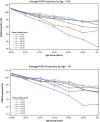Hemophilia without prophylaxis: Assessment of joint range of motion and factor activity
- PMID: 32864554
- PMCID: PMC7443428
- DOI: 10.1002/rth2.12347
Hemophilia without prophylaxis: Assessment of joint range of motion and factor activity
Abstract
Background: Recurrent joint bleeding in hemophilia results in arthropathy and functional impairment. The relationship of arthropathy development and factor activity (FA) has not been reported in patients with FA levels <15%-20%.
Methods: During the Centers for Disease Control and Prevention Universal Data Collection, joint range-of-motion (ROM) measurements were taken at each comprehensive visit. Data were extracted from male patients with hemophilia (PWH) age ≥2 years with baseline factor activity levels ≤40%, excluding those prescribed prophylaxis, and used to calculate a proportion of normal ROM (PN-ROM) measure. Data were analyzed using regression models.
Results: There were 6703 eligible PWH with 30 102 visits. PN-ROM declined with increasing age, and was associated with hemophilia severity, race/ethnicity, obesity, and viral illnesses. PWH ≥30 years old with fFA ≤2% and those ≥50 years old with FA ≤5% had mean PN-ROM values >10% less than controls; those ≥40 years old with FA <1% had values >20% less than controls. In the multivariable analysis, subjects with <1% FA had a 0.43% greater decrease (-0.49 to -0.37, 95% confidence interval) in PN-ROM each year relative to those with 16%-40% factor activity. A less pronounced effect was seen with 1%-5% or 6%-9% FA.
Conclusion: The effect of FA on ROM loss is far greater than that of any of the other characteristics, especially with FA <10%. This emphasizes the need to maintain a high index of suspicion for arthropathy in individuals with moderate and low-mild hemophilia.
Keywords: arthropathy; clotting factor; hemophilia; joint disease; range of motion.
© 2020 The Authors. Research and Practice in Thrombosis and Haemostasis published by Wiley Periodicals LLC on behalf of International Society on Thrombosis and Haemostasis.
Figures
Similar articles
-
Joint range-of-motion limitations among young males with hemophilia: prevalence and risk factors.Blood. 2004 Apr 1;103(7):2467-73. doi: 10.1182/blood-2003-05-1457. Epub 2003 Nov 13. Blood. 2004. PMID: 14615381
-
Joint Function and Arthropathy Severity in Patients with Hemophilia.J Jpn Phys Ther Assoc. 2015;18(1):15-22. doi: 10.1298/jjpta.Vol18_003. J Jpn Phys Ther Assoc. 2015. PMID: 26733762 Free PMC article.
-
Effect of late prophylaxis in hemophilia on joint status: a randomized trial.J Thromb Haemost. 2017 Nov;15(11):2115-2124. doi: 10.1111/jth.13811. Epub 2017 Oct 10. J Thromb Haemost. 2017. PMID: 28836341 Clinical Trial.
-
Past, present, and future of orthopedic surgery in hemophilia: looking to a world without bleeding and arthropathy in the near future.Expert Rev Hematol. 2022 Sep;15(9):821-831. doi: 10.1080/17474086.2022.2110063. Epub 2022 Aug 19. Expert Rev Hematol. 2022. PMID: 35930399 Review.
-
Asymptomatic Joint Bleeding and Joint Health in Hemophilia: A Review of Variables, Methods, and Biomarkers.J Blood Med. 2021 Apr 1;12:209-220. doi: 10.2147/JBM.S304597. eCollection 2021. J Blood Med. 2021. PMID: 33833602 Free PMC article. Review.
Cited by
-
Patient perspective on living with mild hemophilia in Germany: results from a nationwide survey.Front Med (Lausanne). 2024 Feb 5;11:1347024. doi: 10.3389/fmed.2024.1347024. eCollection 2024. Front Med (Lausanne). 2024. PMID: 38379557 Free PMC article.
-
Concizumab improves clot formation in hemophilia A under flow.J Thromb Haemost. 2024 Sep;22(9):2438-2448. doi: 10.1016/j.jtha.2024.05.020. Epub 2024 May 28. J Thromb Haemost. 2024. PMID: 38815755
-
Real-World Evidence on Joint Condition in Non-Severe Hemophilia A Patients: A Multicenter Study.J Blood Med. 2025 May 19;16:251-258. doi: 10.2147/JBM.S517596. eCollection 2025. J Blood Med. 2025. PMID: 40417706 Free PMC article.
-
Clinical and Humanistic Burden of Non-inhibitor Haemophilia A in Five European Countries: Insights from the CHESS II Study.Adv Ther. 2024 Oct;41(10):3888-3904. doi: 10.1007/s12325-024-02956-0. Epub 2024 Aug 17. Adv Ther. 2024. PMID: 39153051
References
-
- Srivastava A, Brewer AK, Mauser‐Bunschoten EP, Key NS, Kitchen S, Llinas A, et al. Guidelines for the management of hemophilia. Haemophilia. 2013;19(1):e1–47. - PubMed
-
- Centers for Disease Control and Prevention HTC Population Profile ‐ January 2012 to March 2019. 2019. [Accessed 2017 September 7] Available from: https://www.cdc.gov/ncbddd/hemophilia/communitycounts/data‐reports/2019‐3
-
- Roosendaal G, Lafeber FP. Pathogenesis of haemophilic arthropathy. Haemophilia. 2006;12(suppl 3):117–21. - PubMed
-
- National Hemophilia Foundation Medical and Scientific Advisory Council Recommendation #241 Concerning Prophylaxis ‐ Regular Administration of Clotting Factor Concentrate to Prevent Bleeding. www.hemophilia.org: National Hemophilia Foundation; February 27, 2016. [Accessed 2017 July 26] Available from: https://www.hemophilia.org/sites/default/files/document/files/241Prophyl....
-
- Manco‐Johnson MJ, Abshire TC, Shapiro AD, Riske B, Hacker MR, Kilcoyne R, et al. Prophylaxis versus episodic treatment to prevent joint disease in boys with severe hemophilia. N Engl J Med. 2007;357(6):535–44. - PubMed
LinkOut - more resources
Full Text Sources


